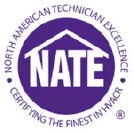What You Should Know About
Smart Home HVAC Systems
SMART THERMOSTATS AND COMMUNICATING SYSTEMS
When speaking with customers, we get numerous questions about what a smart home is and what the technology entails. We answer questions about what brands are best or will it really make a difference in a home. This stems from everywhere you look, there is a “smart” version of home products, and you’re probably wondering, “What does that even mean?” You probably ask the same question when you hear that you need to get a “smart” HVAC system. You roll your eyes and think it’s just some sales gimmick or feature to get more money from you. Well, the truth is not quite, and we’ll explain why.
CHOOSING THE RIGHT OPTION FOR YOUR HOME:
You’ve more than likely heard of Nest, Ecobee, and several other companies that make smart thermostats or other gadgets to make your home “smart.” While these products add functionality, there are restrictions on the benefits they can provide.
These smart thermostats offer a variety of features and technology, but because they are “add-on” pieces to your HVAC system, they’re limited in control of the system and ability to increase efficiency. They are an aftermarket product existing outside of the manufacturing of HVAC equipment. On the other side, you have a connected HVAC system, like the Evolution systems from Bryant, which are designed from the ground up around this smart technology so that they can control your HVAC system at every level, increase efficiency, and reduce noise. This allows customers to have optimal control over their home’s comfort and energy-efficient savings in the palm of their hands. However, while you have the highest level of control of your equipment, you trade off some convenience because you are slightly limited on third-party integrations like Google Home.
WHAT WE RECOMMEND FOR COMPLETE SMART HVAC CONTROL:
The Bryant Evolution system uses the Connex thermostat to control the AC and the Furnace. This functionality is a massive benefit to the homeowner because it will learn your patterns to adjust your usage for when you’re home and keep your home at the temperature you use the most. Because the system also has a variable speed blower, it can recognize your habits and use less energy to maintain your optimal comfort temperature and save you even more money on your energy costs.
This efficiency level is very different from the operating limitations of a Nest thermostat. The Nest programming has limited control capabilities. It requires you to run your system at 100% all the time, which negates any energy savings you might gain from having a smart thermostat. The reason is that the thermostat doesn’t fully communicate with the HVAC equipment, preventing homeowners from using the variable speed functionality in the new air conditioning system. The other major drawback is that always using your system at 100% capacity causes more wear on the equipment and shortens the lifespan of your air conditioner.
However, the Bryant Connex control allows the system to use the different pieces of equipment in tandem. Suppose you have a Bryant Heat Pump with an electric furnace. The Bryant Connex uses your personalized comfort settings to decide when to use the furnace versus the heat pump to create the most energy-efficient performance profile by measuring multiple inputs such as humidity, ventilation, and more, all while keeping your home at your desired temperature.
RECOMMENDED SMART THERMOSTAT:
If you want to upgrade your home with a Smart thermostat versus installing a new HVAC system, consider Ecobee. While this is an aftermarket thermostat, it is a cutting-edge smart thermostat that learns your home’s heating and cooling habits based on your family’s schedules and preferences. While this is still an aftermarket thermostat, it offers the best programmable options. It is also equipped with Alexa integration and responds to voice commands. You see this Smart thermostat brand less often because it requires a licensed HVAC Technician to install and program the controls with your equipment. So while there is the added step of having a Tech install it, you guarantee that the functionality works appropriately and unlocks the full benefits of a smart system.
These are only a few examples of things to consider when upgrading your home to a smart system. While technology is ever-changing, it is good to research and understand what apps and suppliers work best with your HVAC system. It’s important to remember that just because you see a “smart” thermostat doesn’t mean it will give you all the benefits you would get from a wholly connected HVAC system.
If you want to learn more about connected systems from Bryant, call us at Superior Service!
Schedule SMART HVAC Estimate Today!
If you are considering upgrading the technology in your home to use smart technology capabilities, Superior Heating Cooling Plumbing is here to help. We have created our own St Louis home automation system installation team, ready to customize a solution to meet your needs. Call us at (314) 209-7500 today to start turning your home into a smart home.
To set up your home furnace repair today, call our office or fill out the online form below.
"*" indicates required fields





